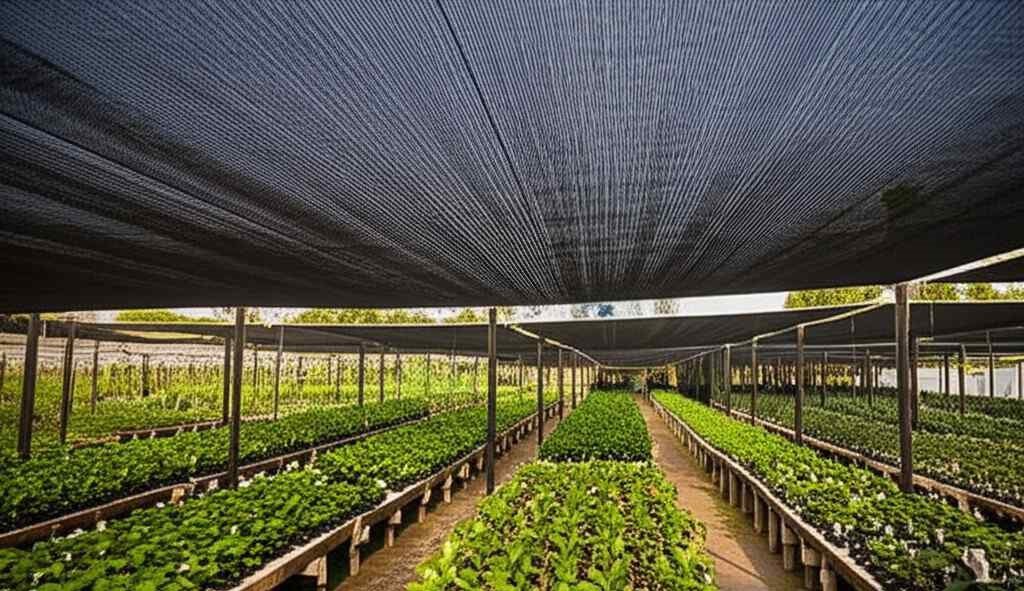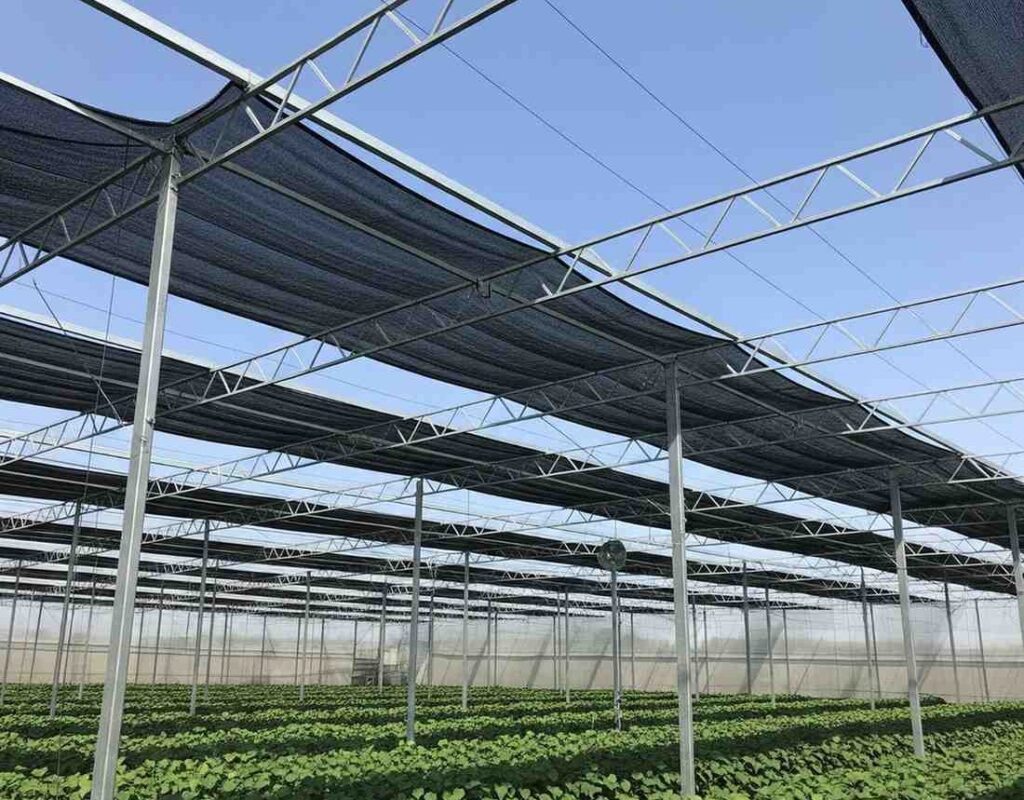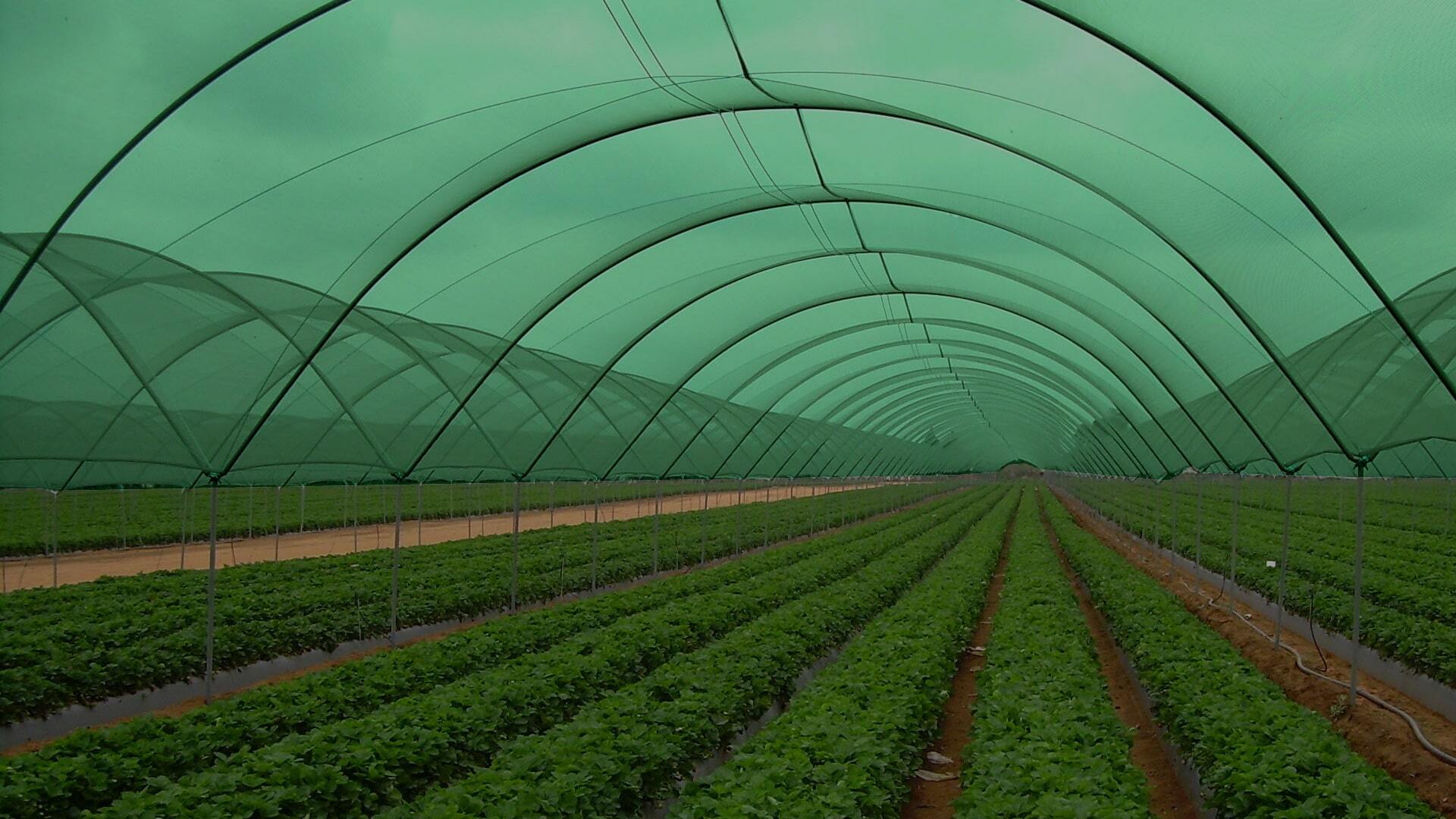Turning Desert Sunshine into Plant‑Friendly Light
Dubai’s blazing sun can force greenhouse temperatures past 40 °C, halting growth and spiking irrigation. Shade nets convert harsh rays into usable PAR light, dropping inside temperatures by 8–12 °C while preserving humidity, with no power‑hungry chillers required.
How Shade Nets Optimise Plant Light & Heat?
Shade nets reduce solar radiation and infrared heat while still allowing the PAR (Photosynthetically Active Radiation) spectrum your crops need. The result is:
- Cooler canopy temperatures → less flower drop and sun‑scald.
- Stable humidity → slower evaporation, lower transpiration stress.
- Gentler light diffusion → even growth, stronger stems, deeper colour.
Rule of Thumb: Every 10 % shade factor can lower greenhouse temperature by ≈ 1.5 °C.
How Can Shade Net Be Used to Help Your Garden?

Shade netting enhances gardening versatility:
- Vegetable Beds: Install overhead nets to protect tomatoes, cucumbers, and herbs.
- Flowering Plants: Use coloured nets (red or blue) to influence bloom intensity.
- Seedling Trays: Cover nursery areas to reduce transplant shock.
- Hanging Gardens and Balconies: Install vertical nets to reduce radiant heat and allow climbing plants to flourish.
Pro Tip: Removable or roll-up netting gives you seasonal flexibility and better crop control.
Choosing the Right Shade Factor & Colour for Popular Crops
|
Crop / Stage |
Recommended Shade % |
Best Net Colour |
Notes |
| Leafy greens (lettuce, spinach) | 40–50 % | White / Aluminised | Prevents tip‑burn, retains crispness |
| Fruiting veg (tomato, pepper) | 30–40 % | Green / Black | Avoids heat‑induced blossom drop |
| Cucumbers & melons | 35–45 % | Aluminised | Cuts bitter flavour linked to heat |
| Seedling trays & nurseries | 50–60 % | Green / Black | Reduces transplant shock |
| Ornamentals & cut flowers | 45–55 % | Red / Blue | Light spectrum enhances colour |
| Exotic ferns & shade plants | 60–70 % | Black | Mimics forest‑floor dappled light |
Not sure which combo suits your crop mix? Get a crop‑specific recommendation
Choose the Best Shade Net for the Garden
Not all shade nets are created equal, especially when it comes to gardening in the UAE. Choosing the right shade percentage, GSM, and colour makes the difference between healthy growth and sun-scorched plants. For residential gardens, a 50–60% shade net in green or white offers the ideal balance between sunlight and cooling. Look for UV-stabilised HDPE materials with tear resistance and airflow-friendly mesh. Lightweight nets (180–220 GSM) are ideal for raised beds and pergolas, while heavy-duty options (250–300 GSM) suit large gardens or high-wind areas.
Tip: Install nets 1.5–2.5 m above garden beds to allow airflow and maintenance access.
Advantages of Shade Net Gardening
Shade net gardening offers more than just protection; it optimises the microclimate. Here’s how:
- Reduces Heat Stress: Shade nets lower plant leaf temperature by up to 10–15 °C, preventing wilting and sunburn.
- Water Efficiency: Less sun means lower evaporation, saving up to 30% on irrigation.
- Improved Photosynthesis: Diffused light penetrates the canopy better, encouraging even growth.
- Longer Growing Season: Sensitive plants like lettuce, spinach, and coriander can be grown during hotter months.
- Pest Control: Fine mesh acts as a barrier to aphids, moths, and leaf miners.
Result: Healthier plants, lower water bills, and higher-quality yields, especially in the UAE climate.
Why Shade Nets Transform UAE Greenhouses?

In Dubai’s blazing heat, a greenhouse can quickly turn into an oven without proper shading. Installing shade nets over or inside a greenhouse helps to:
- Control solar gain to maintain optimal 25–30 °C interior temperature.
- Protect delicate crops from sun scorch and heat-induced flowering issues.
- Enhance crop colour and size through balanced light exposure.
- Reduce cooling energy costs, especially when paired with passive ventilation.
Bonus: Shade netting systems are modular, making them ideal for both high-tech hydroponic setups and traditional soil beds.
Integrating Shade Nets into Greenhouse Design
Fixed Roof Screens vs. Retractable Systems
- Static external netting → budget‑friendly, best for season‑long shading.
- Internal sliding curtains → protect from dust storms, easily retract at dusk.
- External retractable roofs → highest yield boost; sensors open/close nets to maintain ideal PAR and temperature.
Upgrade an existing structure? Request a retrofit plan
Step‑by‑Step Retrofit Guide
- Assess load & structure → confirm truss strength for external nets.
- Select GSM & shade% → match to target crops.
- Choose mounting hardware → stainless eyelets & anti‑rust cables.
- Install edge wire first → tension perimeter to prevent sag.
- Secure centre lines → support wires every 1.5–2 m.
- Fine‑tune tension → nets should drum when tapped, with 2% slack.
- Test ventilation → confirm fans or roof vents still deliver airflow.
Prefer a turnkey installation? Book our greenhouse retrofit crew
Maintenance & Hygiene for Horticultural Nets
- Bi‑monthly wash‑down with low‑pressure water jets to clear dust.
- Annual disinfecting using mild peroxide solution to kill algae/spores.
- UV inspection each season; replace if fibres become brittle or translucent.
- Store off‑season nets rolled and bagged to block light & rodents.
Extend shade net lifespan. Read our maintenance tips
Water‑Use Efficiency & Lower Operating Costs
Studies in arid climates show that shade nets can:
- Reduce evapotranspiration by 20–30 % → fewer irrigation cycles.
- Cut greenhouse cooling loads up to 40 % when combined with ventilation.
- Increase fertiliser uptake efficiency thanks to steadier root‑zone temperatures.
Savings go straight to your bottom line, especially with rising water and electricity tariffs in the Gulf.
ROI: Yield Gains vs Shade Investment
Typical UAE case studies show:
- Tomato yield +15% in summer cycles due to lower blossom drop.
- Cooling electricity by 35% when shade nets replace daytime chiller use.
- Payback 1.5–2 seasons when nets are paired with energy curtains.
Pest & Disease Management Benefits
Fine‑mesh (40–50 mesh) shade nets double as insect exclusion screens, blocking:
- Whiteflies, aphids and thrips that spread viral diseases.
- Leaf‑miner moths and beetles that scar leaves and fruit.
A cooler, less humid environment also slows fungal pathogens like powdery mildew.
Need food‑safe, pesticide‑free protection? Explore our insect‑proof net range
Future‑Ready Shade Net Technologies
|
Innovation |
Benefit for Growers |
| Photo‑selective pigments (red, blue, pearl) | Manipulate vegetative vs flowering growth |
| UV‑blocking insect nets | Fewer pests without chemicals |
| Biodegradable PLA nets | Reduce plastic waste on the farm |
| IoT‑linked retractable screens | Automated climate control |
| Anti‑dust, self-cleaning coatings | Maintain PAR, cut labour |
Conclusion
Shade nets make the UAE sun an ally, cooling, protecting, and boosting yields while saving water and energy. Choose the right shade factor, install correctly, maintain well, and watch your garden or greenhouse flourish.
Ready to grow smarter? Speak to a shade‑net expert
Frequently Asked Questions
Do Plants Grow Better Under Shade Cloth?
Yes, if the right cloth is used for the crop and climate. Shade cloth improves:
- Light Quality: Scattering light prevents leaf scorching while maintaining photosynthetic value.
- Moisture Retention: Slows evaporation, keeping soil and roots cooler.
- Structural Strength: Reduces wind load and physical leaf damage.
However, over-shading can reduce yield. Selecting 30–50% shade for most vegetables and 60–70% for ornamentals or shade-loving species is important.
Conclusion: Smartly chosen and well-installed shade cloth helps plants not just survive but thrive in the UAE's extreme environment.
Can shade nets help reduce plant transplant shock in nurseries?
Yes. Using 50–60% shade nets in nursery setups lowers light intensity and ambient temperature, creating gentler conditions for seedlings. This reduces water loss through transpiration, minimises heat stress, and increases transplant survival rates.
Are coloured shade nets (like red or blue) beneficial for flowering plants?
Absolutely. Photo-selective nets in red or blue can enhance bloom intensity and plant pigmentation by influencing specific light wavelengths. These are particularly effective in greenhouses growing ornamentals, cut flowers, or photoperiod-sensitive plants.
What’s the best way to combine shade nets with irrigation systems?
Shade nets reduce evaporation, meaning irrigation frequency can be decreased by 20–30%. Drip irrigation or misting systems work best under shade nets, as they deliver water precisely while preventing over-saturation caused by reduced sunlight.
Can shade nets be reused for different crop seasons or plant types?
Yes, if properly maintained. UV-stabilised shade nets with a mid-range shade factor (40–50%) offer flexibility for rotating crops. With correct storage and cleaning, the same netting can support different planting cycles across the year.




